Loading AI tools
Class of explosive materials From Wikipedia, the free encyclopedia
Hazmat Class 1 are explosive materials which are any substance or article, including a device, which is designed to function by explosion or which, by chemical reaction within itself is able to function in a similar manner even if not designed to function by explosion.[lower-alpha 1]

Class 1 consists of six 'divisions', that describes the potential hazard posed by the explosive. The division number is the second number after the decimal point on a placard.[lower-alpha 2] The classification has an additional layer, of categorization, known as 'compatibility groups', which breaks explosives in the same division into one of 13 groups, identified by a letter, which is used to separate incompatible explosives from each other. This letter also appears on the placard, following the number.[lower-alpha 3]
The movement of class 1 materials is tightly regulated, especially for divisions 1.1 and 1.2, which represent some of the most dangerous explosives, with the greatest potential for destruction and loss of life. Regulations in the United States require drivers have and follow a pre-prepared route, not park the vehicle within 300 feet (91 m) of bridges, tunnels, a fire, or crowded places.[1] The vehicle must be attended to by its driver at all times while its parked. Drivers are also required to carry the following paperwork and keep it in an accessible and easy to locate location: written emergency instructions, written route plan, a copy of Federal Motor Carrier Safety Regulations, Part 397 - Transport of Hazardous Materials; driving and parking rules. [2] Some tunnels and bridges severely restrict or completely forbid vehicles carrying Class 1 cargoes.[3][4]
| United States Department of Transportation Placards | United Nations GHS hazard pictograms | Division number | Risk | Examples |
|---|---|---|---|---|
 | 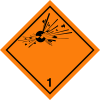 | (N/A) | Basic placard for explosive materials - Division not specified | Anything listed below |
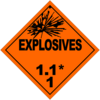 | 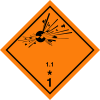 | 1.1 | Substances and articles which have a mass explosion hazard | |
 |  | 1.2 | Substances and articles which have a projection hazard but not a mass explosion hazard | Hand grenades |
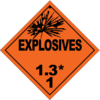 | 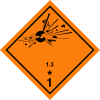 | 1.3 | Substances and articles which have a fire hazard and either a minor blast hazard or a minor projection hazard or both | Display/commercial grade fireworks, rocket propellant |
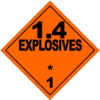 | 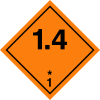 | 1.4 | Substances and articles which present no significant hazard; only a small hazard in the event of ignition or initiation during transport with any effects largely confined to the package | |
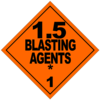 |  | 1.5 | Very insensitive substances which have a mass explosion hazard | Type E water emulsion blasting agents |
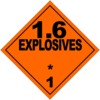 |  | 1.6 | Extremely insensitive articles which do not have a mass explosion hazard | |
| Load and segregation chart | ||||||||||||||||||||||
|---|---|---|---|---|---|---|---|---|---|---|---|---|---|---|---|---|---|---|---|---|---|---|
| Weight | 1.1 | 1.2 | 1.3 | 1.4 | 1.5 | 1.6 | 2.1 | 2.2 | 2.2 | 2.3 | 3 | 4.1 | 4.2 | 4.3 | 5.1 | 5.2 | 6.1 | 7 | 8 | 9 | ||
| A | B | A | ||||||||||||||||||||
| 1.1 | Any quantity | |||||||||||||||||||||
| 1.2 | Any quantity | |||||||||||||||||||||
| 1.3 | Any Quantity | |||||||||||||||||||||
| 1.4 | 1,001 lb (454 kg) | O | O | O | O | O | O | |||||||||||||||
| 1.5 | 1,001 lb (454 kg) | |||||||||||||||||||||
| 1.6 | 1,001 lb (454 kg) | |||||||||||||||||||||
| Key | ||||||||||||||||||||||
The absence of any hazard class or division or a blank space in the table indicates that no restrictions apply.
| ||||||||||||||||||||||
| Compatibility table for class 1 materials | |||||||||||||
|---|---|---|---|---|---|---|---|---|---|---|---|---|---|
| A | B | C | D | E | F | G | H | J | K | L | N | S | |
| A | |||||||||||||
| B | 4 | 4/5 | |||||||||||
| C | 2 | 2 | 3 | 4/5 | |||||||||
| D | 4 | 2 | 2 | 3 | 4/5 | ||||||||
| E | 2 | 2 | 3 | 4/5 | |||||||||
| F | 4/5 | ||||||||||||
| G | 4/5 | ||||||||||||
| H | 4/5 | ||||||||||||
| J | 4/5 | ||||||||||||
| K | 4/5 | ||||||||||||
| L | 1 | ||||||||||||
| N | 4/5 | ||||||||||||
| S | 4/5 | 4/5 | 4/5 | 4/5 | 4/5 | 4/5 | 4/5 | 4/5 | 4/5 | 4/5 | 4/5 | ||
| Notes | |||||||||||||
A blank space in the table indicates that no restrictions apply.
Except as provided in the following paragraph, explosives of the same compatibility group but of different divisions may be transported together provided that the whole shipment is transported as though its entire contents were of the lower numerical division (i.e., Division 1.1 being lower than 1.2). For example, a mixed shipment of Division 1.2 materials and Division 1.4 materials, both of compatibility group D, must be transported as Division 1.2 materials When Division 1.5 materials, compatibility group D, are transported in the same freight container as Division 1.2 materials, compatibility group D, the shipment must be transported as Division 1.1 materials, compatibility group D.
| |||||||||||||
Seamless Wikipedia browsing. On steroids.
Every time you click a link to Wikipedia, Wiktionary or Wikiquote in your browser's search results, it will show the modern Wikiwand interface.
Wikiwand extension is a five stars, simple, with minimum permission required to keep your browsing private, safe and transparent.